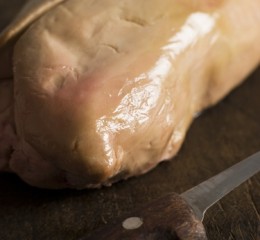


A French traditionThe French speciality, foie gras, is made from duck liver or (less often) goose liver from birds which have been specially raised.In traditional farms found in the Basque Region, the ducklings spend their first fortnight inside a building. They then freely roam, eating the vegetation growing in their vast enclosure and going either to a nearby river or lake. The ducks live in the open air and semi-liberty for 12 – 16 weeks before force-feeding starts.Force-feeding uses the natural capacity of geese and ducks to stock their fat before their long migratory flights. When farmed, this lasts 2 – 3 weeks. Great skill is required to avoid injuring, or over-stressing, the animal - the latter can result in a bad foie gras. The operation requires passage of a tube gently down the animal's throat. Some damp, cooked maize is fed to it, with the quantity and frequency increasing over time. Between each feeding, the animal must have the time to digest and the more the feeding progresses steadily the better for the animal.
For a liver to be called 'foie gras' it must weigh at least 300g. Depending on how it is prepared, it is either foie gras cuit (cooked), semi-conserve (pasteurised) or mi-cuit (half-cooked). In every case, the first step is to remove the veins from the liver.This requires patience, skill and above all a sharp, pointed knife. While deveining, care must be taken not to damage the liver. To get foie gras cuit the liver is placed in a jar and put in the oven at 100°C. Hermetically sealed, it must be kept out of the light for at least a year before being eaten. As for foie gras en semi-conserve it is pasteurised and kept refrigerated for up to a year; while foie gras mi cuit is cooked at a low temperature and then kept refrigerated for only 4 months. In our view mi cuit is by far the tastiest and smoothest of the three.
There are certainly other methods of preparing foie gras: stuffed, medallion or roast. France, as a country devoted to gastronomy, has lots of ideas for using it with other items (see Eating Foie Gras)Raw foie gras (cru) is perfect ... and utterly pure. The great restaurateurs use raw foie gras for making different types of foie gras (entier, cuit, mi-cuit, cuit au sel). When raw, it can also be cooked in a pan after being deveined. This delicate operation has to be done on medium heat. A close eye must be kept on the pan to cook the liver escalope on both sides (turned with the help of a large spatula) without making it disappear altogether. After being carefully deveined and the lobes saved this meal can be prepared.Raw foie gras can be kept for up to 7 days at a temperature between 0 - 4°C.